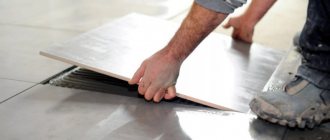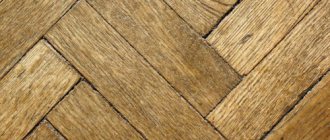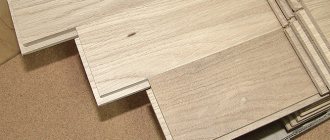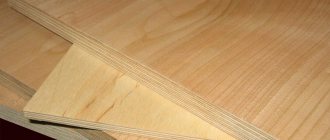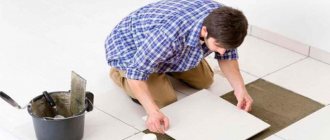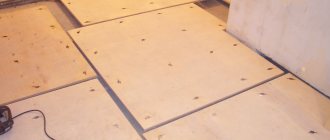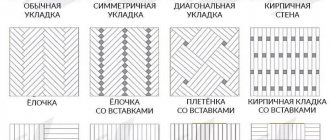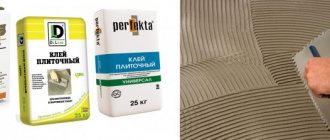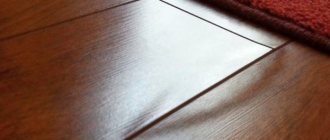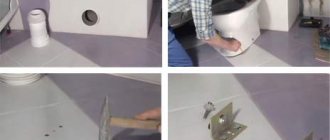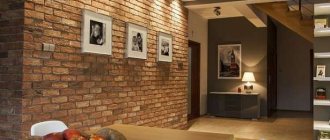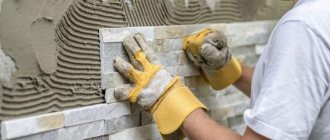Choosing glue for plywood, in most cases, is not difficult. In this case, you need to start from what the plywood is attached to. In construction, this multilayer wood material is used as a subfloor under linoleum, laminate or parquet. In everyday life, you may need to glue plywood sheets together or mount them to another wooden surface. For each type of work, glue is selected individually.
How to drill pilot holes for screws
Learn to prevent plywood from cracking by making proper holes for fasteners. Traditional screws with a tapered shaft require drilling a mounting recess for the smooth part and a guide channel for the threaded part, plus you also need to deepen the head. Perform these operations in one go with a combination drill bit with a tapered tip and an adjustable countersink.
Diagram of drilling holes for traditional screws.
Advice.
Screw brass screws along the thread made in the guide hole with a steel screw of the same size.
Modern screws have a straight shaft and a thinner thread at the top, so they do not require a mounting recess. It is convenient to drill guide holes using the same combined equipment, but with a regular drill selected for each caliber of screws.
Diagram of drilling holes for modern screws.
Self-tapping screws with a drilling tip and countersinking ribs on the head, which make it possible to avoid preliminary drilling in soft wood, often cause splits when twisted along layers of plywood. Don’t take risks and don’t waste time replacing a cracked workpiece - even make holes for screws with a drill at least half the depth and especially near the edges and ends.
Advice. Calculate the tightening force by selecting the appropriate screwdriver mode. It is better to leave the cap sticking out a little above the surface and tighten it with a screwdriver.
It is not necessary to determine the size of the guide hole with an accuracy of fractions of a millimeter - this can be done “by eye”.
The diameter is suitable if the attached drill covers the body of the screw and not the thread.
When making recesses for the caps near the edge of the plywood sheet, apply masking tape to the drilling site so as not to destroy the top veneer.
When drilling guide holes, fix the parts, preventing movement of the workpieces and, as a result, breakage of the drill.
Any fastening of plywood parts will be neat and reliable only if the workpieces are accurately adjusted. Make strictly perpendicular cuts to the workpieces. Always start by making the groove and then fit the tongue to fit it.
It is very important that the floor in the apartment is warm and comfortable. Therefore, its installation begins with laying plywood, which will act as a base and can ensure its stability and strength. This material, consisting of several layers of veneer made from coniferous wood, is susceptible to various types of fastening
It can be mounted with screws, nails or bolts
This material, consisting of several layers of veneer made from coniferous wood, is susceptible to various types of fastening. It can be mounted using screws, nails or bolts.
What glue should I use?
To answer this question correctly, first decide how large pieces of plywood you want to join and how to use it after gluing.
For gluing construction (rough) plywood that does not have a facing layer, any adhesive composition is suitable. The main thing when joining is to clean and degrease the surfaces of the sheets to be glued together as efficiently as possible.
When gluing large sheets to each other after applying the glue, the workpieces are pressed using temporary clamps.
If when gluing plywood it is important not to disturb the texture and color of the material, but to ensure a reliable connection, we recommend using PVA if the workpieces will be used indoors in the future. If we are talking about outdoor use, then epoxy or phenol would be ideal.
To ensure a strong and reliable connection of workpieces, it is important not only to choose the right glue, but also to use it correctly. Because violation of technical regulations is fraught with the “failure to work” of all the qualities of the adhesive composition
For gluing plywood blanks, we recommend using adhesives that meet the following requirements:
- Easy to use, suitable for household needs;
- Provides reliable fastening;
- Resistant to moisture;
- Inert to the effects of fungus and mold;
- Color and composition that do not disturb the composition.
Additional recommendations
In addition to the recommendations described above regarding working with laminated and other materials, you need to take into account that to create a more durable connection, you should use the glue with which the plywood is impregnated. However, it is also necessary to pay attention to the purposes for which the sheets will be used in the future.
How to glue plywood together with your own hands?
How to glue plywood
Most modern flooring is laid on a subfloor rather than directly on concrete. One of the most popular types of substrate is plywood.
It is attractive due to its ease of installation and affordable price; we should also not forget about the important fact that it is a natural material. Its popularity is evidenced by the fact that manufacturers have begun producing a moisture-resistant type for use in bathrooms. Also, the sanded variety on one side is gaining great popularity, which facilitates installation under the final floor covering.
Also, the sanded variety on one side is gaining great popularity, which facilitates installation under the final floor covering.
Choosing the right substrate is not enough, the main thing is to choose a good glue for gluing plywood to concrete. It depends on it how firmly the sheets will stick to the floor, how quickly everything will dry and you can move from preliminary work to final work.
Types of glue
The huge assortment presented on the shelves of construction stores can be divided into several main types:
- water based;
- polyurethane;
- epoxy.
These types of glue for plywood on concrete floors differ in price, composition, consumption and drying time.
PVA glue for plywood
But besides its advantages, it also has its disadvantages:
- takes a long time to dry (up to 7 days for large volumes);
- suitable only for interior work in heated rooms (there is an option marked D with frost-resistant additives, but its price is much higher);
- the fastening of the base to the flooring is not very strong, so the sheets must be screwed with self-tapping screws until they dry completely;
- When using this type of glue, the floor must be fairly level, the difference cannot be more than 2 mm.
Polyurethane adhesive has high strength, viscosity and ductility. It can be either two-component or one-piece.
Two-component adhesive for plywood on concrete floors has a high viscosity (applied with a comb trowel). This is both an advantage and a disadvantage. On the one hand, it sets in literally half an hour, but on the other, it cannot be prepared in large portions “in reserve,” as it quickly dries out and becomes unusable.
The solid version takes much longer to dry, so it does not harden during installation. Complete drying takes 36 - 48 hours, and the strength of the resulting layer exceeds concrete and can withstand changes up to +55 ° C.
Installation of plywood with glue
The disadvantages include:
- high toxicity, but harmful substances are released only during installation, after hardening it becomes safe;
- two-component mixtures harden too quickly, which creates inconvenience during the work process.
Epoxy adhesive for plywood on concrete floors also consists of two components that must be mixed before installation. Complete drying occurs after 4-5 days, but you can walk on the plywood covering within a day.
Read the topic: how to properly lay plywood on a concrete floor.
When laying, harmful substances are also released into the air (due to the alcohol base, the smell is rich and pungent), so you need to work in compliance with safety precautions. Safety glasses, gloves and a respirator must be present, no matter what glue you used to glue the plywood to the concrete floor.
But there are a few general rules:
- The concrete must first be cleaned of construction debris and other contaminants (vacuum or wet clean if necessary).
- It is advisable to prime it before work - this will reduce the consumption of raw materials and improve adhesion to the surface. For these purposes, both a primer (regular or water-repellent, for damp rooms) and the glue itself are suitable. It must be diluted and applied in a thin layer to the prepared surface.
- Although only PVA and its water-based analogues require additional fastening, when working with the rest, for better adhesion, it is also advisable to press the sheets with something to the floor (put them under pressure) until completely dry.
- It is best to cut the sheets into 0.5x0.5 squares, so they will fit better without creating cavities in uneven areas. Such squares are laid in a checkerboard pattern, or simply offset.
- It is necessary to leave a technological gap of 2 - 5 mm between the sheets.
- Depending on the condition of the surface (cracks, unevenness, contamination) and the selected type of glue, the consumption will be 0.5 - 1.5 kilograms per square meter.
Laying plywood on a concrete floor
The PVA label often says “consumption from 0.25 kilograms per square meter,” but don’t get your hopes up. This type of glue must be coated not only on the concrete base, but also applied to the sheet. Therefore, when calculating consumption, the numbers indicated on the label should be multiplied by two.
Laying on the frame
Plywood floors on joists are formed using the following technology:
- Supporting parts are set with a fixation step of 40–60 cm. It is taken into account that all products must be placed in the same plane.
- The treated slabs must be laid in a checkerboard pattern so that the joints fall on the timber. To fasten the products, wood screws are used. A distance of 15–20 cm is formed between the screws.
- Before fixing the flooring, the logs must be treated with antiseptics and fire retardants.
For flooring in domestic premises, logs can be laid in increments of about half a meter, and for highly loaded rooms, logs are installed at a distance of 150 - 200 mm
Attention! With a distance between the support beams of up to 40 cm, the optimal sheet thickness is 12 mm, 60 cm - from 15 mm.
How to use?
After choosing and purchasing glue, you need to decide on the type of connection. The gluing technologies here will vary slightly in each specific case. Let's look at some of them.
Gluing sheets of plywood to each other
In this case, the plywood can be glued or spliced.
When gluing, a ledge is formed at the junction of two sheets. The joints are cleaned with sandpaper, dust is removed and degreased. Both sheets are coated with glue according to the instructions. If necessary, wait a while. Then the surfaces are tightly pressed together. If necessary, fasten with clamps or hardware until the adhesive dries.
Splicing is used in cases where the seams will not be subjected to serious loads in the future. The ends of the plywood are sanded and glue is applied. After joining, the seam is once again lubricated with adhesive and covered with fiberglass, after which it is compacted with a roller.
When the glue is completely dry, remove any excess. Fiberglass fabric is left to enhance the strength of the joint.
When splicing, you can use another method. The sheets are placed on top of each other, and a “mustache” is made with a jointer (their length is approximately equal to 10 sheet thicknesses) along the edge at an angle. Next comes grinding, degreasing the surfaces, and applying glue. The joints are compressed and secured with hardware or clamps until dry.
Gluing plywood to wallpaper
In this case, the best option would be to use moisture-resistant plywood. The usual one will need to be treated with drying oil and paint. When gluing wallpaper onto plywood, water-based and water-dispersion types of glue are used.
In this case, it will be difficult to create a perfectly flat surface. The joints of plywood sheets must be sanded, puttied, and then treated with epoxy or acrylic paint. Use masking tape along the edges of the sheets.
Pasting must be carried out taking into account the type of wallpaper.
Gluing foam rubber to plywood
Plywood is often used in furniture production. When gluing it to foam rubber, styrene or neoprene adhesives, as well as dispersion ones, are most often used.
Glue is applied with a gun or brush
It is important to adhere to the drying time of the glue, which is indicated in its instructions. Glue is applied to one of the surfaces, and the parts are pressed tightly against each other
When using some solutions, the surfaces, after compression, are ironed with a hot iron through the cloth.
Thus, a properly selected adhesive composition can significantly facilitate working with the material. Many experts also recommend priming the surface before gluing. Applying primer improves adhesion and reduces glue consumption.
You can learn how to properly glue two sheets of plywood with PVA glue from the video below.
Problems
When planning to work with plywood and ceramic tiles, you need to consider:
- humidity can lead to surface deformation;
- stability of the structure itself, deflection can cause tiles to fall out.
It will not work to glue tiles to plywood with ordinary glue; moisture will cause the plywood surface to swell:
- drywall. The tiles are laid on it very well, it is an intermediate covering;
- paint or varnish. We paint the surface of the plywood or open it several times with varnish. A painted or varnished surface will not allow moisture to pass through;
- liquid Nails. They fix the plywood surface well;
- silicone sealant. Reliability during bending and minor vibrations;
- acrylic tile adhesive.
Plywood is a very affordable and versatile building material. It is suitable for the production of furniture, apartment partitions, niches, and drawers. You can glue it, paint it, put wallpaper and ceramic tiles on it, and do almost anything you see fit with it. Using plywood in your work, you will understand what it means to create and enjoy the result of your work for many years to come.
Tips for choosing glue
How to glue laminate and how to choose the right material? It is important to take into account the basic criteria by which all such compositions are produced. They must be resistant to moisture, otherwise gluing will not make sense
The glue must also provide excellent adhesion to the substrate. Below are other rules for choosing a product.
Base for laminate
You can glue the laminate board to concrete (screed), plywood, OSB. Depending on the type of substrate chosen, you should look for an adhesive composition. It must be suitable for the base material, providing sufficiently strong adhesion.
Purpose of the premises
The load on the floor must be taken into account when selecting glue. If laminate is installed at home, the loads are moderate, but in shopping centers, stores, and office spaces, the special hardness and strength of the adhesive is important.
Conditions of use
In addition to the load, it is necessary to provide for the frequency of contact with water. Sealing of joints and the ability to withstand certain operating conditions are also written in the instructions for the glue. These characteristics should not be neglected.
Temperature resistance
Typically, laminate is used only inside heated rooms; it is not used at subzero temperatures. Therefore, temperature fluctuations are taken into account mainly when installing heated floors. But the use of the adhesive method for heated floors is seriously limited and is almost never practiced; only a professional can perform such a task.
Drying time
The shorter the curing time, the more difficult the installer’s job. If a dry film forms on the surface of the composition, adhesion to the surface deteriorates. A longer time between application and polymerization will be more convenient for the master, and will also ensure high quality and good adhesion.
Therefore, you should not strive for a minimum drying time; it is better to wait a sufficient period before starting to use the coating.
Category not found!
sh: 1: —format=html: not found
The parquet company PARKET CRAFT has been successfully operating in the Moscow region for more than 7 years.
Our main goal is to perform high-quality parquet work with a guarantee at sites in Moscow.
Our areas of work:
- Laying of Parquet coverings, piece parquet, solid boards, French Christmas tree.
- Restoration and restoration of parquet that was already in use.
- Tinting parquet in various colors and shades.
- Finish with glossy varnish or extra-matte oil with hard wax.
We use an integrated approach to work: Full-time craftsmen (without the involvement of third-party companies), Our own tools, Tested material, which we supply to the site for work (or a reliable and trusted manufacturer). Only in this case we provide a full guarantee for our work.
The employees of our company are craftsmen with experience in the past, and gaining experience and knowledge of technology at the present time, through seminars and attending master classes.
The tools and equipment used are exclusively professional, excluding various grinders for grinding and hacksaws for cutting parquet.
We adhere to the standard work schedule: working week during working hours. But very often we use accelerated mode, night work and other time necessary to complete the assigned tasks.
Individuality for each specific object is a priority in our work.
Scheme of work:
- Telephone consultation (we announce preliminary prices, work deadlines)
- Inspection of the planned work site by a technologist.
- Drawing up estimates, deadlines and payment procedures.
- We start work at the appointed time.
- Delivery of work.
To achieve high quality when performing parquet work, we use a more individual method of work rather than a template - a conveyor type.
Formula for a reliable parquet floor:
- Best material
- Modern equipment
- Highly qualified master
For any questions, call our contact numbers (495)648 - 59 - 63
Parquet scraping More details
Parquet tinting Read more
Parquet service from Parket Craft!
Performing parquet work is the specialization of our company’s craftsmen. We restore parquet floors after long-term use, 60-100 years. After all the work is completed, the parquet is like new again. We use the latest technology for maximum comfort. We always strive for maximum results: durability, ecology, comfort in operation.
For different cases when repairing or changing color, we use different technologies. Oil-wax combinations are very popular for children's rooms - 100% environmentally friendly materials. When laying parquet, we recommend a specific type of parquet according to customer requirements: solid boards, piece parquet, or parquet modules.
With us, parquet scraping always has the character of thrift. We try to preserve the valuable layer of wood as much as possible so that the parquet can be sanded more than once.
- Parquet Sanding (0)
- Parquet Restoration (0)
- Parquet Repair (0)
- Parquet Tinting (0)
- Parquet scraping (0)
- Parquet Restoration (0)
- Decking Board (0)
- Parquet Varnishing (0)
- Oil Coating (0)
- Scratches on Parquet (0)
- Brushing Parquet (0)
- Parquet Care (0)
Right angles are the main rule of assembly
Homemade mounting squares will help you set right angles.
The use of mounting angles for joining plywood parts.
Make several sets of these simple devices of different sizes with your own hands from pieces of chipboard and use them when assembling large and small products.
Details of the mounting angle: 1 – corner; 2 – long bar; 3 – short bar.
Saw a square piece measuring 290x290 mm diagonally.
Manufacturing of mounting angles for joining plywood parts.
Mark the cutouts for the clamps on the corners and cut out the excess material.
Prepare the side strips and make countersunk holes in them.
Secure the corner to the workbench by placing pads of suitable thickness under it. Tighten the screws, drilling pilot holes.
Cut a right angle at the junction of the planks so that during assembly it does not interfere with the tight fit of the parts.
Ready-made mounting angle for joining plywood parts.
You can also make a mounting square with your own hands from thick plywood. Side strips are not needed here; the material is strong enough to be secured with clamps directly to the end of the device.
Drawing of a plywood mounting bracket.
The simplest connection: butt mount
The easiest way to join two pieces of plywood is to butt them end-to-end. It is best to use self-tapping screws as fasteners. If you use screws, the holes for them must be drilled in advance.
Butt fastening is used for thick sheets of plywood. It is considered strong enough for use in furniture production. Its strengthening is facilitated by the facade piping and the pressure exerted by neighboring modules.
Attention! The diameter of the self-tapping screw or screw should not exceed 1/3 of the sheet thickness. So, for 15 mm plywood, fasteners with a diameter of 4–5 mm are suitable.
Types of glue for fixing plywood to the floor
Water based glue
Water-based adhesives are the answer to the question of whether it is possible to glue plywood to a wooden floor without releasing strong odors and maintaining an environmentally friendly atmosphere. Therefore, it is recommended for use in residential areas.
It is best to use them to glue moisture-resistant wood.
But water-based adhesives also have disadvantages:
- they take a long time to dry;
- require additional fastening with dowels.
If communications are laid in concrete, and there is no diagram of their location, then you will have to abandon the use of nails or dowels so as not to inadvertently damage the electrical wiring. Otherwise, the floor will have to be opened with diamond cutters, the damaged wire will be corrected, and the concrete will be re-concrete.
Main types of water-based adhesives:
- polyacrylate;
- latex containing artificial rubbers;
- PVA (emulsion of polyvinyl acetate in water);
- contact compounds.
One-component adhesive
One-component adhesive for plywood floors contains a non-flammable solvent, but when using it, the screed must first be primed. Here you also need dowels for intermediate fixation.
Toxicity requires good room ventilation and the use of a respirator.
In addition to the solvent and polymer, one-component polyurethane adhesives contain a hardener - isocyanate, adhesion enhancers and other additives.
This glue has a number of advantages:
- perfectly penetrates into voids and cracks, which makes it possible to increase the solidity of the subfloor;
- after drying, the glue remains elastic, so it does not crack during use;
- used for plywood made from types of wood prone to deformation from high humidity.
Two-component adhesive
Any two-component adhesive for plywood on a concrete floor, due to its fast reaction (hence they are called reactive), sets very quickly and produces a durable and very strong seam. Buying glue from two components is much easier than gluing it, since immediately before use it is necessary to mix the resin with the hardener in the required proportions.
When working with this glue, you should wear personal protective equipment.
The price of glue for plywood on a concrete floor, consisting of two components, is significantly higher than that of one-component adhesives, but there are also plenty of advantages:
- no intermediate fastening with dowels or screws is required, which saves effort, money and time;
- after the glue has quickly hardened, you can start sanding the surface of the chipboard much earlier;
- provides the highest bond strength.
Video on how to glue plywood to a concrete floor with two-component adhesive:
Two-component adhesive composition
This is the most durable parquet adhesive currently known. The two-component composition is based on polyurethane, which provides excellent adhesion to concrete and wooden substrates. Before use, a hardener must be added to the polyurethane mixture, which is why the glue is called two-component.
The glue contains no water or solvents. The hardener reduces the curing period of the adhesive by half compared to solvent-based adhesives. The time for complete hardening is approximately a day.
Polyurethane glue is very durable, universal - it can be used on any substrate: wood, plywood, concrete. It is used for laying any parquet material, including exotic types (merbau, bamboo), of any size. It can be used to lay even expensive artistic parquet.
Uzin brand two-component polyurethane parquet adhesive is an excellent solution for installing solid wood boards.
Advantages of glue:
- drying time from 24 to 30 hours;
- high elasticity, resistance to deformation;
- resistance to temperature fluctuations;
- moisture resistance, good adhesion.
The polyurethane composition is not afraid of high temperatures, making it quite suitable for combination with a floor heating system.
Flaws:
- the main disadvantage of two-component parquet adhesive is its high cost, which is fully justified by its excellent qualities and durability of use;
- Another drawback: 2-component parquet adhesive cannot be applied to floors with a humidity of more than 4%.
Be aware: before the end of hardening, the two-component composition releases harmful substances. For this reason, they work with polyurethane mixtures in respirators. Once cured, the glue is not hazardous to human health.
Main varieties
When choosing an adhesive for splicing plywood, you must take into account the requirements for the following compositions:
- ease of use;
- viscous or semi-viscous consistency;
- fast hardening;
- absence of volatile toxic substances in the composition;
- resistance to moisture;
- presence of antiseptic properties (not affected by bacteria).
For plywood that is located indoors, any compositions can be used. For splicing materials used outdoors, synthetic glue is suitable; for moisture-resistant boards, it is based on urea resin.
Aqueous or water-dispersed
Among similar adhesive compositions, PVA is most popular. These products do not contain toxic substances or components that emit unpleasant odors. The glue gains sufficient strength within a day, but it takes 2-3 days to completely harden. Due to the fact that PVA and other similar products are water based, these products cannot be used to bond plywood sheets with a porous surface that absorbs moisture.
Carpentry
The basis of carpentry compositions are fats of animal origin: casein and albumin. Both products are available in the form of a dry mixture, which must first be diluted in water. Albumin compounds are used for hot gluing, due to which the created joint gains strength faster.
Based on urea and phenol formaldehyde
Adhesives based on this type contain natural resins that are less toxic than epoxy ones. Compositions of this type are used exclusively for joining wooden products. Glue with such a base creates a transparent seam, so similar products are used to repair decorative elements.
Epoxy and polyurethane
The basis of such compositions are solvents containing toxic substances and emitting a pungent odor. Therefore, it is recommended to work with such products in ventilated areas or outdoors.
Epoxy adhesives are divided into one- and two-component. Compositions of the first type are immediately ready for use. Two-component products consist of an adhesive and a solvent, which must be mixed before starting work. Such compositions are used for rapid joining of various materials, including wood.
Popular brands
When choosing an adhesive composition for plywood, it is also recommended to pay attention to the manufacturer’s brand. The higher the demand for a product of a particular brand, the more likely it is that the purchased product meets the above requirements.
Artelit
A Polish brand specializing in the production of adhesive compositions intended for joining wooden products, including plywood and parquet. The Artelit company produces various types of similar products. The range of products of this brand contains waterproof and fast-hardening adhesives.
Bostik
A French brand under which a variety of construction products are produced. The Bostik company produces adhesive compositions based on PVA, polyurethane and others.
"Rogneda"
A Russian brand that specializes mainly in universal mixtures. Rogneda products are not inferior in quality to foreign analogues, but they are affordable.
Titebond
An American company specializing in the production of adhesives intended for floor coverings.
Sequence of work
Before gluing wallpaper, you need to properly prepare the surface of the walls:
When fastening the sheets, the screws should be literally sunk into the wood so that the caps in no case protrude above the surface. After this, all fasteners are treated with special anti-corrosion compounds, otherwise rusty spots will quickly appear on the surface of the canvas. After installation, plywood must be covered with a layer of primer. The composition must contain special anti-mold additives
This is especially important for vinyl wallpaper. The joints between individual plates must be sealed with putty, otherwise they will be visible through the canvas, especially paper. The same applies to any defects, including microcracks, knots, and nail marks. After the putty has dried, it is necessary to sand the surface and coat it with primer again.
Scheme of wallpapering procedure.
It is best to use non-woven wallpaper for a plywood wall. They perfectly mask various defects, since the canvas is quite thick.
How is plywood prepared? Plywood after covering the wall has seams between the individual slabs and fastening points. All such joints and fastenings must be sealed, otherwise they will be clearly visible. If rough plywood was used for work, the walls are first sanded and then cleaned of dust. Next, they are covered with a moisture-resistant primer, all joints and fastening points are puttied.
When the mixture has dried, it is necessary to sand the surface again so that it becomes perfectly flat and smooth. If non-moisture-resistant plywood was used to cover the walls, then it is recommended to paint the wall with a special alkyd enamel; water-based enamel cannot be used. If waterproof plywood was used for the work, then after all the mixtures have dried, the walls must be treated with a regular vacuum cleaner, which will collect all the dust so that it does not interfere with the adhesion of the glue.
Choice
The best material for wallpaper is vinyl. Plasticized polyvinyl chloride will provide reliable protection against moisture, and the elasticity of the wallpaper will not cause it to tear. They are durable and do not require specific or additional care.
Non-woven wallpaper is suitable for painting. They are elastic and textured, which will hide all the defects of the plywood sheet. They look good on the walls and can be repainted every time, changing the interior.
- grinding. Particular attention should be paid to the joints of the sheets;
- putty. Acrylic, for wooden surfaces. Pay attention to seams and screw recesses;
- primer. Diluted glue or any acrylic glue is perfect;
- Wallpaper is usually glued as if on a wall.
Gluing Basics
Production technology
When talking about gluing plywood sheets, we most often mean either the production technology of the material itself, or the connection of several fragments in the manufacture of various products
We will talk about sheet splicing in detail below, and in this section we will try to pay attention to the intricacies of the production process
Most often, gluing veneer to make plywood is done using the hot dry method. Today the following technological schemes are relevant:
- The connection of the prepared veneer plates is carried out using a press while maintaining constant pressure in the working gap. This technology is used for the production of slabs whose thickness does not exceed 8 mm.
- Alternate gluing of veneer at constant pressure with heat treatment. By alternately joining, thicker plywood is made - usually from 10 to 18 mm.
- Multi-stage sizing of workpieces with cooling of the press after each operation makes it possible to increase a significant thickness of the slab. This technique is used to produce sheets with a thickness of 20 mm or more.
However, these technological schemes are of interest only to those who plan to engage in the industrial production of veneer boards
For us, first of all, information on how you can connect several pieces of plywood with your own hands, without the use of presses and thermostats, will be important.
Adhesives used
When choosing what to glue plywood with, you should carefully study all the available options. There are many formulations on the modern market, and therefore it is worth choosing exactly the one that will best meet our requirements.
The bulk of adhesives for plywood are represented by two categories - protein (of animal origin) and synthetic. We will talk about the most popular varieties from each category.
Protein groups include the following:
- Casein - made from cottage cheese that has undergone a defatting procedure. Adhesives are sold in the form of a dry powder; before use, they are dissolved in water and mixed thoroughly.
- Albumin - made from protein obtained from animal blood. The dry component is mixed with water in a ratio of 1:9. The glue curls at a temperature of 70 0 C, which is why albumin compounds are used for hot gluing.
- Combined - combines the components of casein and albumin compositions.
Synthetic adhesives are mainly represented by resinous substances. The most commonly used:
Urea-formaldehyde resins (KF-MT, KF-Zh, etc.). They provide a colorless seam, therefore they are practically indispensable in the manufacture of decorative elements that imitate natural wood.
Almost any adhesive for gluing plywood includes:
- Main adhesive.
- Solvent.
- Filler: wood dust or flour.
- Additives that control the rate of hardening and ensure maximum adhesion.
- Plasticizers.
- Antiseptics.
Substances such as acids or ammonium chloride are used as hardeners, and to ensure resistance to wetting, tannins (formalin, copper salts, etc.) are added to the composition.
Photo - quick-hardening composition in a tube.
In order for the glue to retain its adhesive properties for as long as possible, either ethyl alcohol or acetone is used to dissolve the adhesive component.
Coffee table made from plywood scraps
A lot has been said about how to glue plywood to plywood, but how can you make something useful from this material?
After carrying out various repair work, a lot of plywood scraps remain, which are simply sent to the trash bin.
But these pieces are ideal, for example, for creating an unusual and beautiful coffee table.
List of materials and tools required for work:
- a whole small piece of thick cardboard for a template;
- many plywood pieces of the same thickness, which will make up the main structure;
- moisture-resistant adhesive for wooden surfaces;
- jigsaw;
- pencil;
- vice;
- a circular saw;
- Sander;
